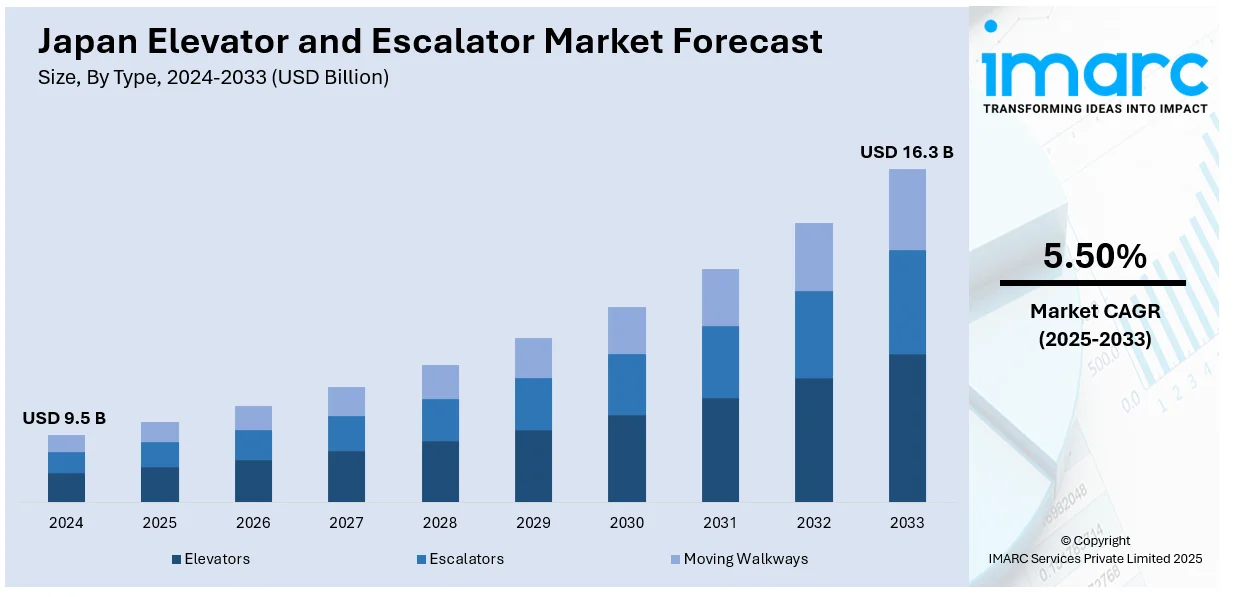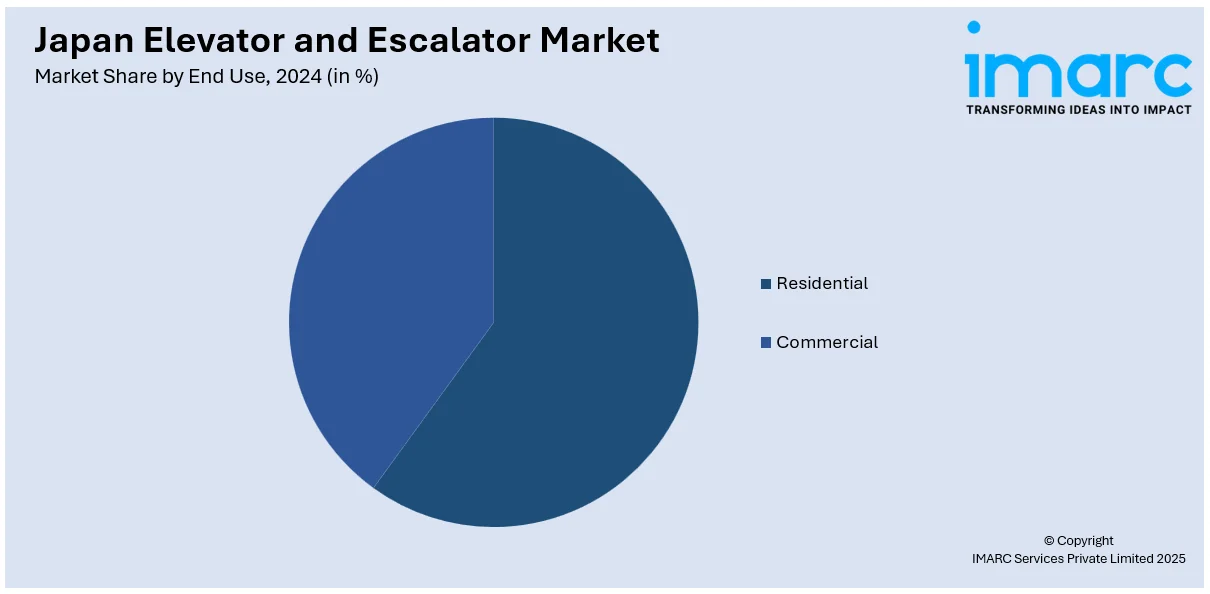
Japan Elevator and Escalator Market Size, Share, Trends and Forecast by Type, Service, End Use, and Region, 2025-2033
Japan Elevator and Escalator Market Overview:
The Japan elevator and escalator market size reached USD 9.5 Billion in 2024. Looking forward, IMARC Group expects the market to reach USD 16.3 Billion by 2033, exhibiting a growth rate (CAGR) of 5.50% during 2025-2033. The market is witnessing significant growth, driven by urban redevelopment, an aging population, and smart building integration. In line with this, modernization of aging infrastructure and compliance with safety standards, especially in residential and commercial sectors are also contributing positively to the market growth in Japan.
|
Report Attribute
|
Key Statistics
|
|---|---|
|
Base Year
|
2024
|
|
Forecast Years
|
2025-2033
|
|
Historical Years
|
2019-2024
|
| Market Size in 2024 | USD 9.5 Billion |
| Market Forecast in 2033 | USD 16.3 Billion |
| Market Growth Rate 2025-2033 | 5.50% |
Japan Elevator and Escalator Market Trends:
Smart Elevator Integration
Intelligent elevator integration is transforming vertical mobility solutions in Japan, especially with the implementation of IoT-enabled technologies. Such systems enable real-time monitoring, predictive maintenance, and customized user experiences, making them more appealing to contemporary urban developments. The Japan elevator and escalator market growth is being driven by this technological revolution, as building owners and facility managers seek to maximize operational efficiency and system reliability. For instance, in March 2024, Nippon Otis Elevator Company provided 14 smart elevators, including four Gen2® Premier lifts, to Tokyo's newly opened Azabudai Hills. Designed by Thomas Heatherwick, the elevators feature a unique curved design and are equipped with advanced digital technology for real-time monitoring, enhancing both functionality and aesthetic appeal in the urban complex. Along with this, manufacturers are providing cloud-based service platforms and AI-based diagnostics to minimize downtime and maximize equipment life. Voice-controlled elevators, destination control systems, and smartphone-based access are also becoming popular in high-rise residential and commercial complexes. The integration of smart features is in line with Japan's emphasis on automation and its necessity to replace old infrastructure. Therefore, intelligent solutions are becoming a decisive factor in growing the Japan elevator and escalator market share, especially in the retrofit and premium segments.

Energy-Efficient Technologies
Energy-efficient technologies are becoming the norm in elevator and escalator systems throughout Japan, which reduces energy consumption and operating costs. Regenerative drives enable elevators to recover excess energy and use it to charge the building's power system. LED lighting in elevator cabins combined with motion sensors, reduces unnecessary energy consumption. Standby modes power down lighting, ventilation, and controls automatically when not in use, which helps in enhanced sustainability. For instance, in October 2024, Nippon Otis successfully modernized 21 elevators and two escalators at Tokyo Metropolitan Bokutoh Hospital, enhancing safety and accessibility. The multi-year project is initiated in 2014, minimized disruption to hospital operations while improving earthquake resistance. Upgrades include energy-efficient LED lighting and wheelchair-friendly design features, ensuring a comfortable mobility experience for all users. These advancements are not only aligned with Japan’s climate goals but also cater to property developers looking to improve building efficiency ratings. Manufacturers are also introducing compact motors and lighter materials to further minimize power usage without compromising performance. Energy efficiency is now a central theme in new installations and modernization projects alike, particularly in high-traffic commercial spaces. These developments play a strong role in shaping the Japan elevator and escalator market outlook.
Japan Elevator and Escalator Market Segmentation:
IMARC Group provides an analysis of the key trends in each segment of the market, along with forecasts at the regional level for 2025-2033. Our report has categorized the market based on type, service, and end use.
Type Insights:
- Elevators
- Escalators
- Moving Walkways
The report has provided a detailed breakup and analysis of the market based on the type. This includes elevators, escalators, and moving walkways.
Service Insights:
- New Installation
- Maintenance and Repair
- Modernization
A detailed breakup and analysis of the market based on the service have also been provided in the report. This includes new installation, maintenance and repair, and modernization.
End Use Insights:

- Residential
- Commercial
- Offices
- Hospitality
- Mixed Block
- Others
A detailed breakup and analysis of the market based on the end use have also been provided in the report. This includes residential and commercial (offices, hospitality, mixed block, and others).
Regional Insights:
- Kanto Region
- Kansai/Kinki Region
- Central/Chubu Region
- Kyushu-Okinawa Region
- Tohoku Region
- Chugoku Region
- Hokkaido Region
- Shikoku Region
The report has also provided a comprehensive analysis of all the major regional markets, which include Kanto Region, Kansai/Kinki Region, Central/Chubu Region, Kyushu-Okinawa Region, Tohoku Region, Chugoku Region, Hokkaido Region, and Shikoku Region.
Competitive Landscape:
The market research report has also provided a comprehensive analysis of the competitive landscape. Competitive analysis such as market structure, key player positioning, top winning strategies, competitive dashboard, and company evaluation quadrant has been covered in the report. Also, detailed profiles of all major companies have been provided.
Japan Elevator and Escalator Market News:
- In December 2024, Fujitec Co., Ltd. announced its plans to launch its new standard elevator model, Ele Glance, in spring 2025. This upgraded model, a successor to XIOR, features 29 color options and three design themes, Smart, Elegant, and Friendly. Enhanced remote monitoring and relocated equipment improve maintenance and flood damage resilience.
- In June 2024, Obayashi Corporation announced its plans to build a space elevator by 2050, starting construction in 2025. The project aims to revolutionize space travel, utilizing climbers to reduce cargo costs significantly. Challenges include tether material selection and safety concerns. The initiative could transform access to space for all of humanity.
- In June 2024, Hitachi secured its largest order in Japan for 173 elevators and escalators for Tokyo's Torch Tower, the country's tallest building at 390 meters. The project includes advanced systems for efficient elevator operation and features Japan's highest outdoor escalators, contributing to the innovative TOKYO TORCH district redevelopment.
Japan Elevator and Escalator Market Report Coverage:
| Report Features | Details |
|---|---|
| Base Year of the Analysis | 2024 |
| Historical Period | 2019-2024 |
| Forecast Period | 2025-2033 |
| Units | Billion USD |
| Scope of the Report |
Exploration of Historical Trends and Market Outlook, Industry Catalysts and Challenges, Segment-Wise Historical and Future Market Assessment:
|
| Types Covered | Elevators, Escalators, Moving Walkways |
| Services Covered | New Installation, Maintenance and Repair, Modernization |
| End Uses Covered |
|
| Regions Covered | Kanto Region, Kansai/Kinki Region, Central/Chubu Region, Kyushu-Okinawa Region, Tohoku Region, Chugoku Region, Hokkaido Region, Shikoku Region |
| Customization Scope | 10% Free Customization |
| Post-Sale Analyst Support | 10-12 Weeks |
| Delivery Format | PDF and Excel through Email (We can also provide the editable version of the report in PPT/Word format on special request) |
Key Questions Answered in This Report:
- How has the Japan elevator and escalator market performed so far and how will it perform in the coming years?
- What is the breakup of the Japan elevator and escalator market on the basis of type?
- What is the breakup of the Japan elevator and escalator market on the basis of service?
- What is the breakup of the Japan elevator and escalator market on the basis of end use?
- What is the breakup of the Japan elevator and escalator market on the basis of region?
- What are the various stages in the value chain of the Japan elevator and escalator market?
- What are the key driving factors and challenges in the Japan elevator and escalator market?
- What is the structure of the Japan elevator and escalator market and who are the key players?
- What is the degree of competition in the Japan elevator and escalator market?
Key Benefits for Stakeholders:
- IMARC’s industry report offers a comprehensive quantitative analysis of various market segments, historical and current market trends, market forecasts, and dynamics of the Japan elevator and escalator market from 2019-2033.
- The research report provides the latest information on the market drivers, challenges, and opportunities in the Japan elevator and escalator market.
- Porter's five forces analysis assist stakeholders in assessing the impact of new entrants, competitive rivalry, supplier power, buyer power, and the threat of substitution. It helps stakeholders to analyze the level of competition within the Japan elevator and escalator industry and its attractiveness.
- Competitive landscape allows stakeholders to understand their competitive environment and provides an insight into the current positions of key players in the market.
Need more help?
- Speak to our experienced analysts for insights on the current market scenarios.
- Include additional segments and countries to customize the report as per your requirement.
- Gain an unparalleled competitive advantage in your domain by understanding how to utilize the report and positively impacting your operations and revenue.
- For further assistance, please connect with our analysts.
 Request Customization
Request Customization
 Speak to an Analyst
Speak to an Analyst
 Request Brochure
Request Brochure
 Inquire Before Buying
Inquire Before Buying




.webp)




.webp)












